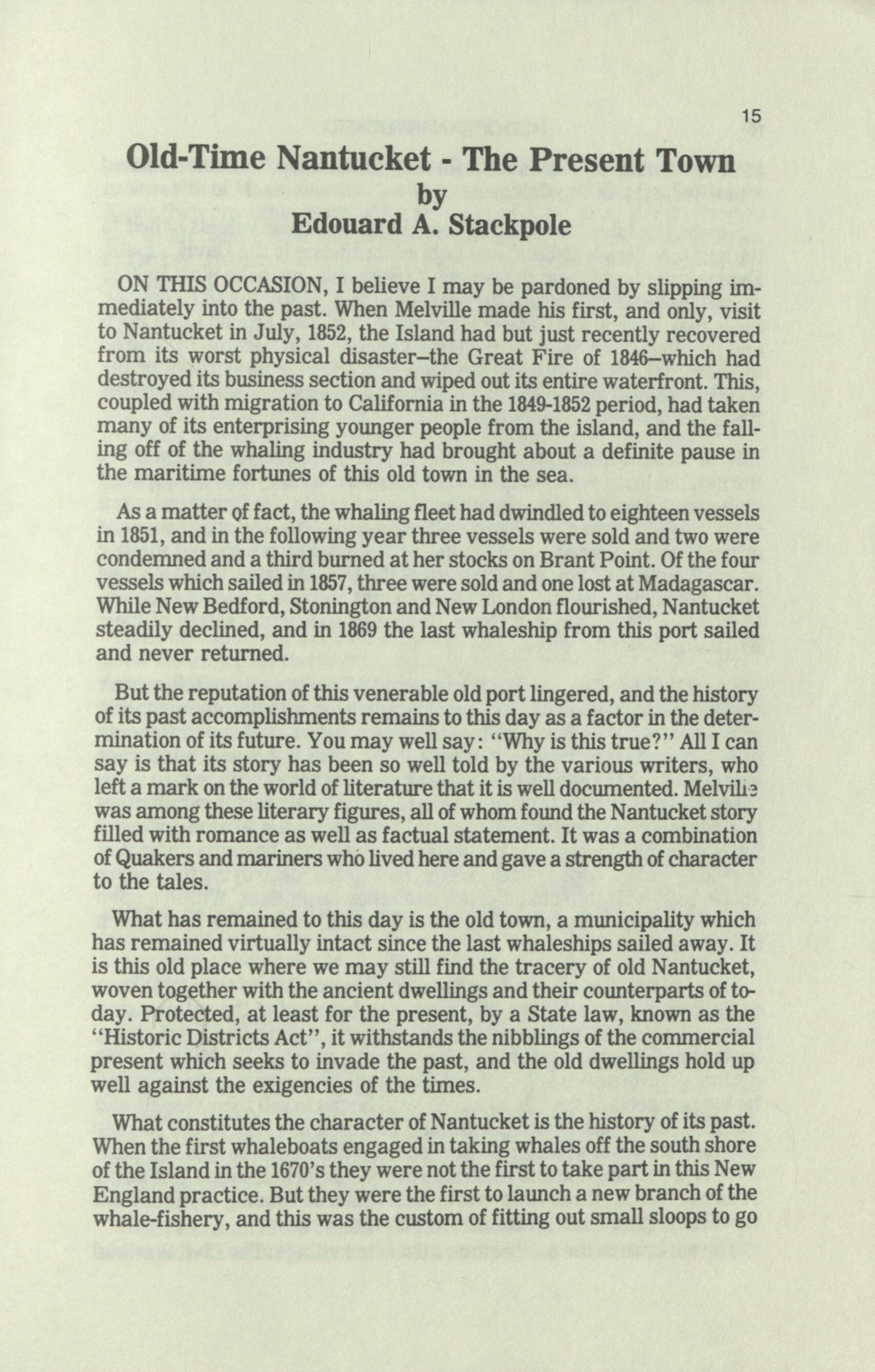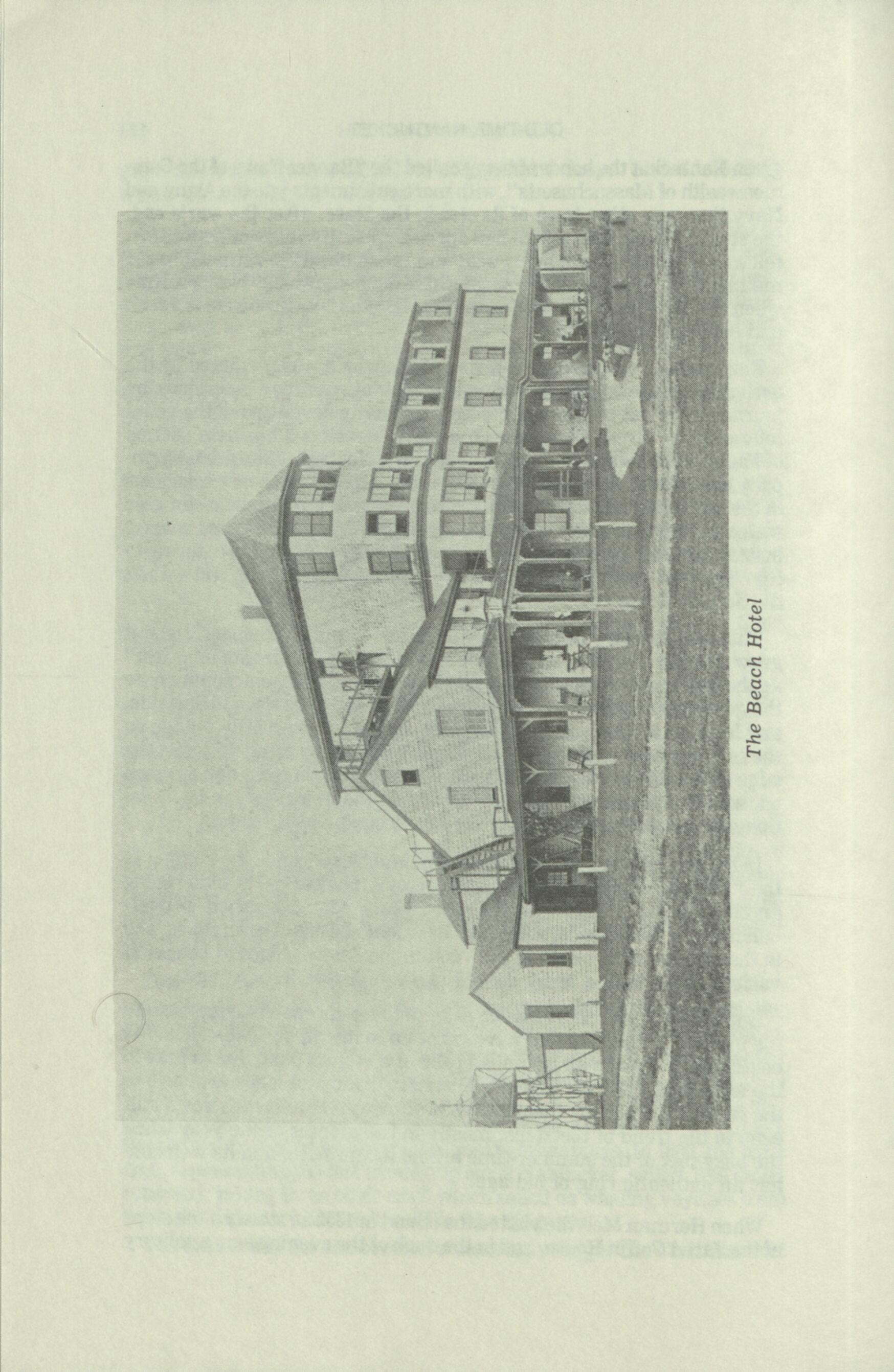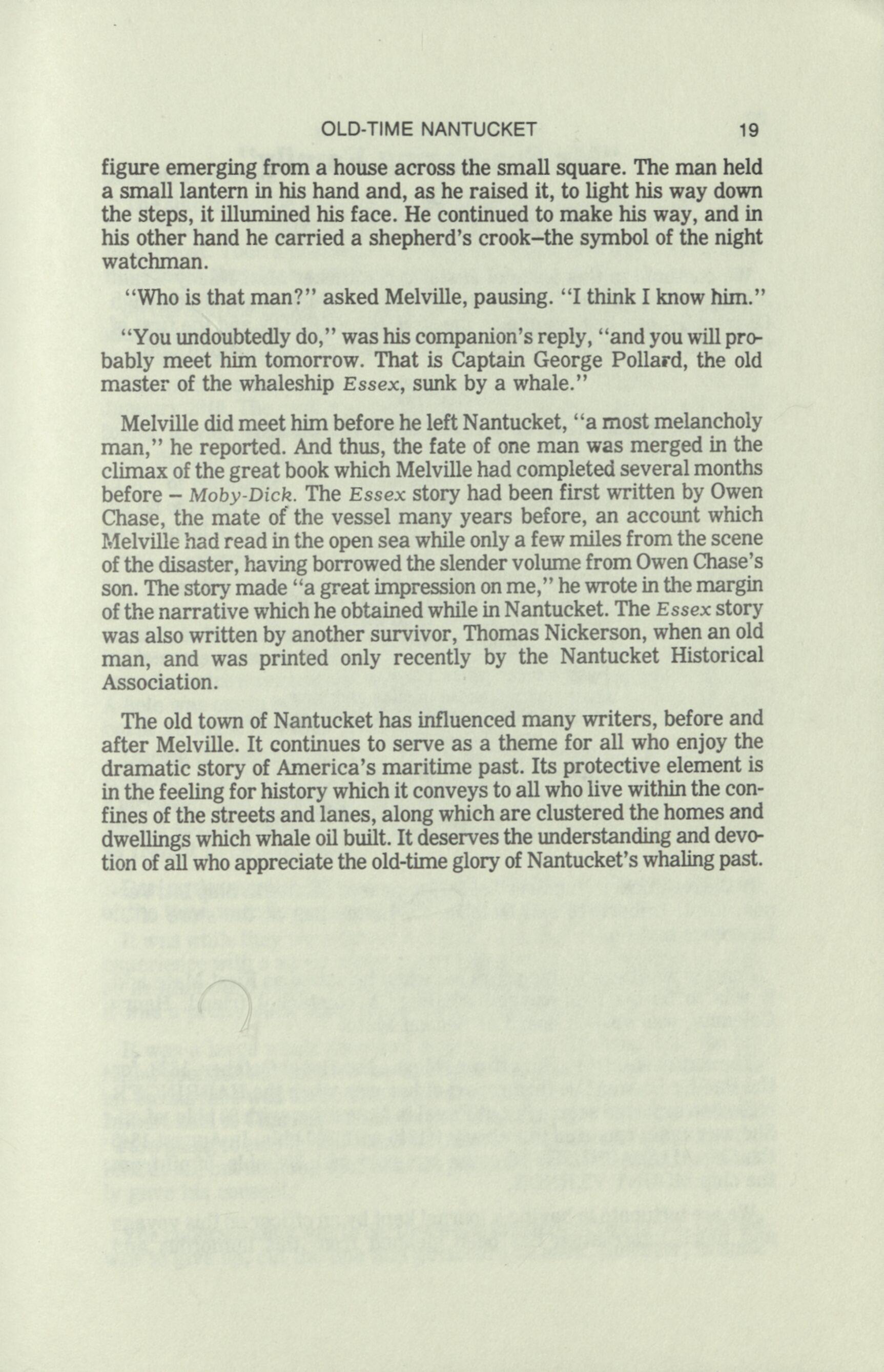
9 minute read
by Edouard A. Stackpole
15
Old-Time Nantucket - The Present Town
by Edouard A. Stackpole
ON THIS OCCASION, I believe I may be pardoned by slipping immediately into the past. When Melville made his first, and only, visit to Nantucket in July, 1852, the Island had but just recently recovered from its worst physical disaster-the Great Fire of 1846-which had destroyed its business section and wiped out its entire waterfront. This, coupled with migration to California in the 1849-1852 period, had taken many of its enterprising younger people from the island, and the falling off of the whaling industry had brought about a definite pause in the maritime fortunes of this old town in the sea.
As a matter of fact, the whaling fleet had dwindled to eighteen vessels in 1851, and in the following year three vessels were sold and two were condemned and a third burned at her stocks on Brant Point. Of the four vessels which sailed in 1857, three were sold and one lost at Madagascar. While New Bedford, Stonington and New London flourished, Nantucket steadily declined, and in 1869 the last whaleship from this port sailed and never returned.
But the reputation of this venerable old port lingered, and the history of its past accomplishments remains to this day as a factor in the determination of its future. You may well say: "Why is this true?" All I can say is that its story has been so well told by the various writers, who left a mark on the world of literature that it is well documented. Melvihe was among these literary figures, all of whom found the Nantucket story filled with romance as well as factual statement. It was a combination of Quakers and mariners who lived here and gave a strength of character to the tales.
What has remained to this day is the old town, a municipality which has remained virtually intact since the last whaleships sailed away. It is this old place where we may still find the tracery of old Nantucket, woven together with the ancient dwellings and their counterparts of today. Protected, at least for the present, by a State law, known as the "Historic Districts Act", it withstands the nibblings of the commercial present which seeks to invade the past, and the old dwellings hold up well against the exigencies of the times.
What constitutes the character of Nantucket is the history of its past. When the first whaleboats engaged in taking whales off the south shore of the Island in the 1670's they were not the first to take part in this New England practice. But they were the first to launch a new branch of the whale-fishery, and this was the custom of fitting out small sloops to go
16 HISTORIC NANTUCKET
after the whale. It was called "whaling in the deep," and it launched a new industry in the Colonies.
Slowly, the Islanders built up their industry. Their vessels sailed to the north, to Newfoundland and Labrador; thence to the Davis Straits. Experience taught them the course: to Bermuda, on to the West Indies; across the South Atlantic to the coast of Africa, in still the 18th century. Soon, they were at the Cape of Good Hope, and then around Cape Horn and into the Great South Seas. Their voyages soon became measured in years, which meant they voyaged into the remote corners of the watery world, learning the vagaries of the unknown oceans, discovering new continents as they sailed.
With the Revolution, the Nantuckers found themselves caught up in the new realm of war. Once through this turmoil they were embraced with a new element - the invitation to embark in the British whalers out of London, then out of France. They migrated to the upper reaches of the Hudson, then to Nova Scotia, seeking help from the old mother country. With the firm establishment of the United States, they took new hope, but during the War of 1812 they sought and won a pact of neutrality with the Royal Navy of Great Britain to ensure the safety of their whaleships.
From 1815 to 1835, the Nantucket whale fleet grew to reach a peak of seventy-five vessels. At this time competition with the other whaling ports-notably New Bedford-had become a factor, and the merchants of Nantucket were finding it strong. Still, with the courage inherent within them, they continued to battle against the heavy odds, until a manmade disaster struck. It was the Great Fire of 1846, a factor culminating in a business disaster, which ultimately destroyed the whaling industry for Nantucket. This great fire destroyed the entire business district of the old town and wiped out the waterfront areas, destroying the cooper shops, sail lofts, ship chandleries, and other businesses. Within a span of 24 hours the conflagration had stricken the old town a blow from which she never recovered.

Then, to cap the climax of economic disaster, came the Gold Rush to California. From 1849 to 1852, over one thousand of the enterprising men of Nantucket embarked on this venture, sailing their own ships, embarking on other craft from nearby ports, many in the later months getting their families to join them. The whaleship owners, discouraged by the prospects of the Island's recovery, began to sell their vessels and the 1855-1865 years marked a decade in which one half of the former fleet of Nantucket whaleships were sold to other ports. In 1869, the bark Oak, representing the last whaleship out of Nantucket, sailed. She never returned, joining three other craft which sailed on whaling voyages from this island port which were sold in foreign ports.
The old town in the sea became a deserted village. The Civil War had
OLD-TIME NANTUCKET 17
given Nantucket the honor of being called the "Banner Town of the Commonwealth of Massachusetts", with more enlistments into the Army and Navy than any other town of its size in the State. After the war's end, the small fishing fleet which had sprung up in the years of depression fell away. Houses were being sold and taken down for removal to the mainland. It was a time of considerable soul-searching. It was a time when the older people contemplated the darkness of the disaster which had befallen the island.
Then came a new industry-a way of life which was predicted by the arrival of visitors, people who were seeking summer diversions by journeying to out-of-the-way places. It actually developed in the years following the Great Fire, when the newly developed business section of Main Street became part of the scene. The Nantucket Steamboat Company, allied with New Bedford and Hyannis, embarked on new schedules in the early 1870's and the slogan "two boats a day" became a summer watchword. Seme of the larger houses in town were opened as rooming houses, and the old wharves became alive with small boats catering to the "tourists" seeking some excitement in fishing parties and sailing the Sound.
This new industry became known as the "summer business," and it grew steadily over the first decade. Then came the "elegant eighties," as the 1880's were called, when new hotels were built to accommodate the growing crowds. A railroad was constructed from town to Surfside, and later on to Siasconset, or 'Sconset, as the growing little village on the Island's east end was called. Houses began to spring up along the edge of the Cliff and on Brant point. By 1900, the old town had spruced up, with the "summer business" providing the livelihood for a population of over 3000 people who lived year-'round on the island.
In the one hundred years which have intervened since the coming of the "elegant eighties" of the last century, Nantucket is undergoing another period of crisis. In the last twenty years, a period of overbuilding has taken place, with stretches along the out-of-town roads, and in the once pristine areas of the "commons," now scenes of houses of various sizes, taking away the old views of a few decades ago.
But the old town still remains, despite these encroachments, despite the inevitable changes that have crept up in its "historic districts." It continues to remain an unspoiled relic of a storied past, due in part to the legal protection of "Historic Districts", and in a large measure to the people who occupy the old houses of today. Its ancient streets still echo to the trend of footsteps, mostly in the months of the year when the busy feet of the summer-time are no longer here, and its welcome has an authentic ring of old age.
When Herman Melville visited the island in 1852 he stood on the steps of the Jared Coffin House, and in the dusk of the evening saw a solitary


OLD-TIME NANTUCKET 19
figure emerging from a house across the small square. The man held a small lantern in his hand and, as he raised it, to light his way down the steps, it illumined his face. He continued to make his way, and in his other hand he carried a shepherd's crook-the symbol of the night watchman. "Who is that man?" asked Melville, pausing. "I think I know him." "You undoubtedly do," was his companion's reply, "and you will probably meet him tomorrow. That is Captain George Pollard, the old master of the whaleship Essex, sunk by a whale."
Melville did meet him before he left Nantucket, "a most melancholy man," he reported. And thus, the fate of one man was merged in the climax of the great book which Melville had completed several months before - Moby-Dick. The Essex story had been first written by Owen Chase, the mate of the vessel many years before, an account which Melville had read in the open sea while only a few miles from the scene of the disaster, having borrowed the slender volume from Owen Chase's son. The story made "a great impression on me," he wrote in the margin of the narrative which he obtained while in Nantucket. The Essex story was also written by another survivor, Thomas Nickerson, when an old man, and was printed only recently by the Nantucket Historical Association.

The old town of Nantucket has influenced many writers, before and after Melville. It continues to serve as a theme for all who enjoy the dramatic story of America's maritime past. Its protective element is in the feeling for history which it conveys to all who live within the confines of the streets and lanes, along which are clustered the homes and dwellings which whale oil built. It deserves the understanding and devotion of all who appreciate the old-time glory of Nantucket's whaling past.






